José María Araúz de Robles Estremera
| José María Araúz de Robles Estremera | |
|---|---|
| Born |
José María Araúz de Robles Estremera 1898 Peralejos de las Truchas, Spain |
| Died |
1977 Vega de Arias, Spain |
| Nationality | Spanish |
| Ethnicity | Spanish |
| Occupation | lawyer |
| Known for | politician |
Political party | Partido Social Popular, Comunión Tradicionalista |
| Religion | Roman Catholicism |
José María Araúz de Robles Estremera (1898 - 1977) was a Spanish Carlist and Alfonsist politician, businessman and bull breeder.
Family and youth
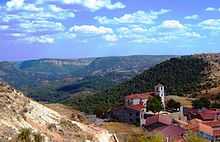
The Biscay Araúz family arrived in the Alto Tajo mountains as miners and foundrymen.[1] They settled in Peralejos de las Truchas and constructed Casa Grande de Araúz in 1816;[2] some joined the Carlists during the Carlist Wars.[3] The great-grandfather of José María was a bull-breeder who in 1905 co-founded what is now Unión de Criadores de Toros de Lidia.[4] A branch of the family kept breeding bulls until 1931, when the Hermanos Arauz brand disappeared from the market.[5] The father of José María, Enrique Araúz Estremera, studied at Colegio Molinés de Padres Escolapios in Madrid[6] and practiced as a doctor in his native village, where he also served as alcalde;[7] also a Carlist, he remained sensitive to social issues and co-operated with the local workers’ periodical, La Alcarria Obrera.[8] In 1895 he published La hija del Tío Paco o lo que pueden dos mil duros.[9] Heavily influenced by José María de Pereda, the book fell into the costumbrismo trend.[10]
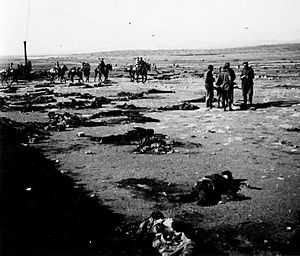
José Maria and his siblings were brought up in a profoundly Catholic atmosphere. Orphaned by father in 1905,[11] he moved to Madrid to attend the Salesian Colegio de San Juan Bautista.[12] He studied law in Universidad Central de Madrid to obtain his PhD laurels in 1919;[13] in 1921 he became Abogado del Estado.[14] Drafted to the army he reduced his term as a soldier de cuota[15] and served in Regimiento Inmemorial del Rey during the Moroccan campaign,[16] witnessing the battle of Annual in 1921. Upon his return married to Mercedes López Ramiro; the couple had 5 sons: Fernando, José Maria, Jesús, Javier and Santiago.[17] Javier married Ana Dávila,[18] daughter of the Falangist politician Sancho Dávila y Fernández. Santiago Araúz de Robles López, a lawyer by profession and a hunter by vocation,[19] apart from juridical contributions[20] is best known as author of novels and essays revolving around rural life,[21] not an unusual Carlist thread.[22] The brother of José María, Carlos Araúz de Robles Estremera, also a lawyer, became an author of multiple works in law/legislation, history and letters, including essays, poetry and novels,[23] also with the costumbrista leaning.[24]
Early public activity
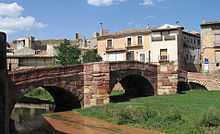
Throughout the 1920s Araúz de Robles practiced law in Huesca, Sevilla, Ávila and Madrid,[25] serving also in the local Molina de Aragón ayuntamiento.[26] In 1922 he co-founded a Christian-Democratic Partido Social Popular, and became a member of its defensa nacional section.[27] In the mid-1920s he published a few short novels: Don Bernardo "el Idumeo" (1922), Si tu supieras! (1923) and Estrella errante (192?),[28] written in a baroque version of costumbrismo,[29] though it was rather his wartime recollections Por el Camino de Annual (1924)[30] that gained more popularity. In 1928 he organized local homages to the molinés soldiers fallen in the Rif War, attended by King Alfonso XII;[31] he also sponsored the monument built at Monte Arruit in Morocco.[32] In the late 1920s Araúz co-founded Asociación Católica de Padres de Familia to become its secretary in the early 1930s.[33] During political disarray of dictablanda, Araúz on various public meetings defended the monarchy and harangued against the republican designs, including these of a conservative format;[34] he donated money to families of those who died fighting the failed republican coup in Jaca.[35] Lobbied for construction of the La Roda – Tarazona railway line, which would cross the Moncayo massif and benefit his native Molina region.[36]
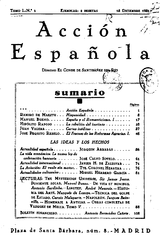
During the first days of the Republic Araúz joined the Agrarian Party[37] and as its candidate unsuccessfully ran for Cortes from the Guadalajara province in 1931.[38] Late 1931 he co-founded the Alfonsist monarchist organization Acción Española and early the following year he set up its journal of the same name.[39] Continuing with his interest in social issues, in 1932 Araúz co-organised Primer Congreso del Pensamiento Social Popular.[40] During 1931-1932 he took part in a number of broadly monarchist public meetings, often jointly with the Traditionalist leaders.[41] Attracted by Carlist intransigence, he drew close to their Comunión Tradicionalista.[42] In the months of 1933-34 Araúz participated in a series of Carlist public meetings, conferences and lectures,[43] sometimes assuming a somewhat revolutionary tone.[44] He formally broke with the Agrarians in 1934; in a letter to its leader, Martinez de Velasco he pointed that political parties and inorganic democracy no longer suited the needs of Spain.[45]
Carlist against the Republic
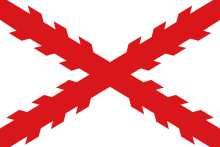
Within Carlism, Araúz became a new rising figure.[46] In the 1933 elections he successfully ran on the Carlist ticket from Granada.[47] In the 1936 elections (also in Granada) he emerged victorious and was even nominated secretary of the Carlist parliamentary minority,[48] but his mandate was cancelled due to alleged irregularities.[49] Araúz conspired against the Republic as member of the La Ferme based Junta Nacional Carlista.[50] Following the outbreak of hostilities he joined the Burgos based Junta Carlista de Guerra[51] and became head of its Guilds and Corporations section,[52] sort of Carlist “ministry of labor” bent to build a syndical structure competitive to the Falangist scheme.[53] Araúz co-engineered the raid of Aragonese Requetés who captured his native Molina de Aragon early August 1936; he later contributed to forming of the local Requeté battalion, Tercio de María de Molina.[54]
Late summer 1936 Araúz strived to install the Catholic Confederación Española de Sindicatos Obreros (CESO) sindicate by the Burgos based Junta de Defensa Nacional.[55] As the Francoist quasi-government banned any trade union activities[56] the Carlists tried to find a workaround by creating Obra Nacional Corporativa in November,[57] an attempt to build own labor structure to be headed by Araúz, and defended its integrity against the Falangist CONS unions.[58] In 1937 he published Plan de la Obra Nacional Corporativa[59] and Corporativismo gremial,[60] sketching rules for the future organization of labor. The vision was based on Christian social theory, laid out in Spain by Severino Aznar Embid and developed ideas drafted in Araúz’s earlier pamphlet La nueva politica: ideas sobre el futuro de España (1929). The works proposed to defuse social conflict by political representation of labor, wage control, pension schemes, unemployment and sick plans, arbitration boards, cooperatives, anti-speculation laws etc. They endorsed a regulated state, though fell short of syndicalism schemes and vehemently criticized fascism;[61] some scholars view it as a hybrid of Christian-social and Traditionalist patterns,[62] though some classify it as corporativism.[63] Carlos Hugo, a future leader of Partido Carlista, would refer to Araúz’s vision in the 1959 Montejurra meeting when commencing his campaign to steer Carlism towards socialism.[64]
Carlist against Franco
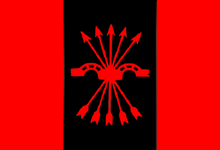
During the meeting of top Carlist leaders in Insua in February 1937 Araúz seemed undecided about the Carlist strategy towards the forthcoming unification threat,[65] concerned more about the unity of Traditionalism.[66] Together with Lamamié de Clairac he talked in Villarreal de Álava to the Falangist leader Manuel Hedilla and agreed that either unification would take place on their terms, or not at all.[67] He is listed as a member of the in-between Carlist group, neither decisively opposing nor decisively supporting the unification,[68] though he soon adopted a dissident stand and in October 1937 got expulsed from Falange Española Tradicionalista.[69] His bid to build Carlist sindicates failed. Though CESO tried to avoid amalgamation by federating within the ONC,[70] Obra Nacional Corporativa was eventually incorporated into the Francoist trade unions[71] and Araúz was removed from integrated labor structures.[72] Personally regarded unfavourably in the Franco headquarters,[73] he enlisted to the Requetes and took part in the Biscay campaign,[74] finally withdrawing from the Francoist political and military structures.

In the early 1940s Araúz, determined to bring the monarchy back, was steering between the Carlists and the Alfonsists. In August 1943 along with Manuel Fal Conde and a number of other Carlist leaders[75] he signed a letter to Franco, demanding that fascistoid features of the regime are replaced with Traditionalist solutions;[76] the response was his detention and a month spent behind bars in the Dirección General de Seguridad prison.[77] Later the same year he conferred with the Alfonsinos concerning their policy towards Francoism. He supported a manifesto to be issued by their claimant Don Juan, a document intended to dissociate the pretender from Franco; in minority, he fruitlessly advocated a bold action.[78] In 1944 he supported vague plans for a joint monarchist coup against Franco.[79] In 1946 together with conde Rodezno he visited Don Juan in Estoril, sounding him on a would-be dynastical agreement between himself and the Carlist regent-claimant Don Javier.[80] Formally the mission did not breach the rules of Carlist regency, but in fact it was bordering disloyalty to Don Javier. In 1957 both Araúz de Robles brothers, José Maria and Carlos, joined a large fraction of Carlists who recognized Don Juan as the legitimate Carlist pretender.[81] The Acto de Estoril declaration marked his formal break with mainstream Carlism. He was expulsed from Comunión[82] and faced anger of the javierista crowd during the Carlist Montejurra amassment of the following year.[83]
Juanista
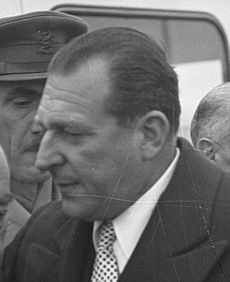
In 1957 Araúz co-founded Amigos de Maeztu, a monarchist lobbying group styled as a literary association,[84] and became its vice-president[85] and a member of Junta Directiva.[86] His relations with Don Juan cooled; Araúz was disappointed by the claimant’s backtracking on his declared Traditionalist outlook, while Don Juan was disappointed by Araúz’s failure to bring all Carlists into his camp.[87] Nevertheless, he remained a member of the juanist Consejo de la Corona[88] and Consejo Privado[89] (though not his Secretariado Político[90]). As advisor to Don Juan he firmly opposed the democratic tendency. In 1961, when El Boletín de la Secretaria del Consejo Privado endorsed a monarchy based on parliamentary party politics, Araúz reacted with a letter to the Council’s head, José María Pemán, voicing his disgust.[91] He presented the same stand in public debate. When ABC published a front-page piece of Rafael Calvo, pointing to a possible co-existence between liberalism and Catholicism,[92] Araúz repelled the thesis.[93] By mid-1960s Araúz discarded his anti-Francoism and pressed a collaborative strategy towards the regime, somewhat against a cautious approach favoured by Pemán and other juanista leaders.[94]
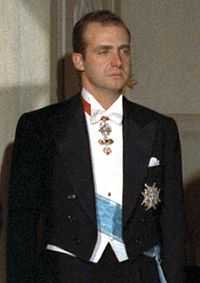
As it became apparent that Franco would ignore Don Juan and mark his son Juan Carlos as the future king, most juanistas found themselves confused. Araúz aligned himself with the official line and re-oriented himself towards the young prince. When in 1966 the ABC daily called on its front page for Don Juan to assume the throne,[95] the issue was forcibly withdrawn from sale;[96] two days later the newspaper published the text of Araúz,[97] who denied his Carlist identity[98] and in Aesopian language argued that Don Juan would be hostage to party politics, while Juan Carlos would be the king of all Spaniards. He later advocated “yes” vote in referendum on Ley Orgánica del Estado,[99] which, however, did not advance the answer to succession question beyond the vague 1947 formula.[100] In late 1960s Araúz tried to approach Juan Carlos and was present during the 1968 baptism of his son, Don Felipe.[101]
Araúz did not make it to the inner circle of the prince, possibly because he remained a firm opponent of democracy. During the final years of Francoism he assailed “political associations” (a long-discussed idea at that time about to materialize[102]) in letters to both popular newspapers[103] and specialized reviews.[104] He tried to prevent the socialist takeover of Carlism[105] by creating a competitive combatant Requeté association[106] or a competitive Carlist political organization, first as Hermandad de Maestrazgo[107] and then as Comunión Tradicionalista,[108] praising also the vritues of Traditionalist Fal Conde in his 1975 obituary.[109] Though his brother Carlos joined Unión Nacional Española, José Maria never has.[110] In one of his last public statements, dated August 1976 and titled “An unanswered message”, Araúz confirmed his mistrust towards democracy.[111]
Bull breeder
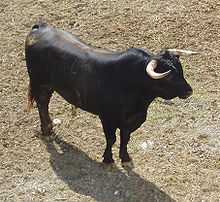
In 1945 Arauz de Robles purchased toro bravo livestock of the local Herederos de Rufo Serrano Muñoz company, shortly before owned by a modest torero, Mariano García de Lora.[112] He energetically ventured to refresh the breed with new studs from Samuel Flores and Guardiola Soto breeds and raised his own sementales. He registered his own hierro in 1947[113] and the same year his bulls (the first one named Asustado[114]) started to appear on the arenas, most notably on the Madrid Las Ventas.[115] In the 1940s Arauz de Robles was aggressively developing the business, co-operating with recognized local ranchers like Vicente Sierra Peiró and purchasing 60-70 cows at local fairs.[116] He specialized in the novillas bulls,[117] gaining notoriety with Choricero (1951).[118] He pursued a fairly unique path by mating of cross-lineage breeds,[119] resulting in some unrepeatability and unpredictability of the bulls.[120] In the 1950s he bought another ranch in the heart of the Andalusian Sierra Morena, which initially served auxiliary purposes.[121]

The lineage became an established brand on the Spanish toro bravo market in the 1950s and early 1960s. In the 1970s Arauz de Robles switched to the mainstream toro do lidia; his ganadería formed one of the 30-odd bull-ranches which served as a point of reference in scientific studies,[122] also taking part in celebrated events like the Pamplona Sanfermines.[123] In 1978 the breed was taken over by his son Francisco Javier Arauz de Robles López, who changed the hierro (1978) [124] and later moved the ganaderia to Jaen province.[125] Initially fairly active,[126] recently it has been rather quiescent,[127] with the owners pointing to a number of difficulties,[128] including competition from Domecq breed.[129] This, plus allegedly declining quality[130] led some organisations[131] to black-list the breed,[132] despite the owner's marketing campaign.[133] The lineage is present on the official UCTL list.[134] Santiago Araúz de Robles López started breeding horses in Baños de la Encina.[135] He has approached bullfighting from the scholarly perspective of a social scientist.[136]
See also
- Carlism
- Francoism
- Corporativism
- Spanish Fighting Bull
Footnotes
- ↑ Herrera Casado, Casonas solariegas de Peralejos de las Truchas, [in:] Rumbo Guadalajara (1993)
- ↑ El Santuario de Nuestra Señora de Ribagordia, vol. 3, Lérida 1948, p. 6
- ↑ Marcos Arauz Gómez served as lieutenant under Carlos V, see El Santuario p. 36
- ↑ See toroslidia site
- ↑ El Tronco Jijón [in:] Terralia 43 (2004)
- ↑ El Santuario... p.37
- ↑ Monumento al Roble del Campillo, [in] Alustante (2008)
- ↑ El Señorío de Molina, [in:] La Alcarria Obrera (2009)
- ↑ La Hija del Tio Paco, O, Lo Que Pueden Dos Mil Duros: Cuadros de Costumbres, reprinted in 1923 and 2013, ISBN 1295364654, 9781295364657
- ↑ José Sanz y Díaz, Ha muerto Carlos Arauz de Robles [in:] Wad-al-Hayara: Revista de estudios de Guadalajara 11 (1984), pp. 411-412, ISSN 02147092
- ↑ ’’El Santuario’’… p. 37
- ↑ ABC 27.11.1977, available here
- ↑ Josep Carlos Clemente, Breve historia de las guerras carlistas, Madrid 2011, ISBN 8499671691, 9788499671697, p. 242; El Santuario… p. 38
- ↑ El Santuario…p. 38
- ↑ Francisco Saro Gandarillas, Los primeros anos de la Cruz Roja en Melilla, [in:] Periodico Melillense 31.05.2007
- ↑ Clemente 2011, p. 242
- ↑ ABC 04.10.1977, available here
- ↑ See for instance ABC 21.07.1990, available here
- ↑ Santiago Arauz de Robles entry at the hunting site trofeocaza here
- ↑ See e.g. Notas sobre el regimen jurídico del patrimonio de la RENFE, [in:] Revista de la administración publica 46 (1965), pp. 321-368, ISSN 00347693; he served also as RENFE manager, see Una nota que puede caracterizarnos es que el cliente se convierta en amigo, [in:] Avance empresarial, March 2008
- ↑ Cuentos de Hombres (1973), De mi rincón, y otras compañías (1977), Los desiertos de la cultura: Una crisis agraria (1979), Con pasos tan sencillos (1980), Idoia (1981), La Agonia Florida de Carlos Brito: Bertin Delgado- La ciudad y los niños (1983), Memoria del paraiso: Uriarte y el general (1984), De cómo Enriquillo obtuvo victoria de su majestad Carlos V (1984), Pepe Luis: Meditaciones sobre una biografia (1988), Diario de preguerra (1991), La Pasión según un hombre de mundo (2000), Tello en varano (2004), ¿Qué hay, Marylin? y El Corpus Chico (2012)
- ↑ see Francisco Javier Caspistegui Gorasurreta, “Esa ciudad maldita, cuna del centralismo, la burocracia y el liberalism”: la ciudad como enemigo en el tradicionalismo español, [in:] En: Actas del congreso internacional "Arquitectura, ciudad e ideología antiurbana", Pamplona 2002, ISBN 8489713510
- ↑ Cataluna y el Mediterraneo (1930), May y tierra (1939), La vuelta al clasicismo; ensayo crítico del liberalismo y su secuela socialista (1939), Universalidad (1944), Defensa del derecho privado (1949), Ensayo sobre una teleología del pensamiento jurídico contemporáneo(1952), Misión social de la cultura aria (1955), La filosofía del derecho público (1957), Teoria de la publicidad (1961), Cadiz entre la revolucion y el deseado. (Apuntes sobre el derecho publico y privado de la revolucion) (1963), Hojas sueltas (1976); see El Santuario… p. 38-9
- ↑ Gareth Thomas, The Novel of the Spanish Civil War (1936-1975) , Cambridge 1990, ISBN 0521371589, 9780521371582, p. 52
- ↑ Clemente 2011, p. 242
- ↑ Inauguracion del busto del capitan Arenas en el PCMMI de Guadalajara, p. 207, [in:] Memorial del Arma de Ingenieros 90 (2013), available here
- ↑ La Vanguardia 12.12.1922, available here, Clemente 2011, p. 242
- ↑ See Araúz at books.google, available here
- ↑ El Santuario…p. 38
- ↑ See his Por el Camino de Annual. Apuntes y Comentarios De Un Soldado De Africa, Madrid 1924
- ↑ La Vanguardia 06.06.1928, available here
- ↑ Inauguracion del busto…
- ↑ José Martín Brocos Fernández, Una pequeńa historia del Carlismo del siglo XX a través de tres semblanzas: Tomás Domínguez Arévalo, José María Arauz de Robles y Francisco Elías de Tejada, [in:] Arbil 120 (2005)
- ↑ ABC 11.11.1930, available here
- ↑ El Imparcial 13.11.1930
- ↑ Brocos Fernández 2005
- ↑ Jacek Bartyzel, „Hiszpański łącznik” Jędrzeja Giertycha, [in:] Organizacja Monacrhistow Polskich site, available here
- ↑ Brocos Fernández 2005
- ↑ Acción Española, 01.01.1932, available here
- ↑ Clemente 2011, p. 242, Martin Blinkhorn, Carlism and Crisis in Spain, Cambridge 2008, ISBN 9780521086349, p. 332
- ↑ Brocos Fernández 2005
- ↑ Some authors point to early 1932, see Bartyzel , some point to December 1932, see Brocos Fernández 2005, some do not specify the date, see Clemente 2011, p. 242
- ↑ Brocos Fernández 2005
- ↑ E.g. calling for “a new spirit … to ventilate and purify the sources of life”, quoted after Blinkhorn 2008, p. 178
- ↑ Brocos Fernández 2005
- ↑ Blinkhorn 2008, p. 161
- ↑ Brocos Fernández 2005; oddly enough, the official Cortes web service does not list him as elected under personal entry and he appears only on a joint list of Granada 1934 deputies, see here
- ↑ Blinkhorn 2008, p. 231
- ↑ Leandro Álvarez Rey, Los Diputados por Andalucía de la Segunda República 1931-1939, vol. 1, p. 128, Sevilla 2009, ISBN 8461313267, 9788461313266; see also Miguel Pertiñez Díaz, Granada 1936: elecciones a Cortes, Granada 1988, ISBN 8433806106, 9788433806109
- ↑ Brocos Fernández 2005; Clemente 2011, p. 242
- ↑ Brocos Fernández 2005
- ↑ Jordi Canal i Morell, Banderas blancas, boinas rojas: una historia política del carlismo, 1876-1939, Barcelona 2006, ISBN 8496467341, 9788496467347, p. 331; Blinkhorn 2008, p. 270; Fermín Pérez-Nievas Borderas, Contra viento y marea. Historia de la evolución ideológica del carlismo a través de dos siglos de lucha, Pamplona 1999; ISBN 8460589323, 9788460589327, p. 108;
- ↑ Blinkhorn 2008, p. 274
- ↑ Julio Aróstegui, Combatientes requetés en la Guerra Civil española (1936-1939) , Madrid 2013, ISBN 9788499709758, p. 538
- ↑ Angela Cenarro Lagunas, Introducción a la edicion digital de “Obrerismo” , p. 16, [in:] Institución Fernando El Catolico, available here
- ↑ Cenarro Lagunas, p. 18
- ↑ Canal i Morell 2006, p. 334
- ↑ Cenarro Lagunas, p. 20
- ↑ Plan de la Obra Nacional Corporativa. Para un resurgimiento de España y del mundo, a un orden nacional y cristiano, Editorial Espanola, Burgos 1937, available here, see also here
- ↑ Corporativismo gremial. La organización social en la España nueva, Editorial Requeté, Burgos, 1937
- ↑ Manuel Martorell Pérez, La continuidad ideológica del carlismo tras la Guerra Civil [PhD thesis], Valencia 2009, p. 256
- ↑ Carlos Ibáñez, Política social y económica del carlismo, referred after Foro Alfonso Carlos 2011, available here; Luis Infante, Economía, Tradición available here
- ↑ José Martín Brocos Fernández, Iniciadores de corporativismo en España. La Experiencia de la O.N.C. , [in:] Arbil 123 (2008), available here
- ↑ Ibáñez 2011
- ↑ Pérez-Nievas Borderas 1999, p. 116, Blinkhorn 2008, p. 282
- ↑ Manuel Martorell Pérez , Navarra 1937-1939: el fiasco de la Unificación, [in:] Príncipe de Viana, 244 (2008), ISSN 00328472, p. 442
- ↑ Josep Carles Clemente, Raros, Heterodoxos, Disidentes Y Viñetas Del Carlismo, Madrid 1995, ISBN 842450707X, 9788424507077, p. 136, Pérez-Nievas Borderas 1999, p. 118
- ↑ Canal i Morell 2006, p. 342, Blinkhorn 2008, p. 286
- ↑ Mercedes Peñalba Sotorrío, Entre la boina roja y la camisa azul. La integración del carlismo en Falange Española Tradicionalista y de las JONS (1936-1942), Estella 2013, p. 67; other authors claim he was only suspended, see Blinkhorn 2008, p. 292
- ↑ Angela Cenarro Lagunas, p. 19
- ↑ Francisco Javier Caspistegui Gorasurreta, El naufragio de las ortodoxias. El carlismo, 1962-1977, Pamplona 1997; ISBN 9788431315641, 9788431315641, p. 108
- ↑ Blinkhorn 2008, p. 292
- ↑ Blinkhorn 2008, p. 288
- ↑ Ibáñez 2011, Infante, Economía…
- ↑ La Vanguardia 04.06.1977, available here
- ↑ Josep Carles Clemente, Historia del Carlismo contemporaneo 1935-1972, Barcelona 1977, ISBN 8425307597, 9788425307591, p. 172
- ↑ Clemente 2011, p. 242
- ↑ Fernando de Meer, La soledad de D. Juan de Borbón. El "no" de los monárquicos del interior a la ruptura con Franco (XII.1943) Análisis de un proceso, p. 169, [in:] Boletín Real Academia de la Historia, CXCIV (1997)
- ↑ Martorell Pérez 2009, pp. 298-300
- ↑ Caspistegui Gorasurreta 1997, p. 23
- ↑ Clemente 1977, p. 299, Pérez-Nievas Borderas 1999, p. 168; Mercedes Vázquez de Prada Tiffé suggests Araúz reacted to Carlos Hugo appearing in Montejurra in 1957, see her El papel del carlismo navarro en el inicio de la fragmentación definitiva de la comunión tradicionalista (1957-1960) , [in:] Principe de Viana 254 (2011), p. 401, ISSN 00328472
- ↑ Bartyzel, „Hiszpański łącznik…
- ↑ Caspistegui Gorasurreta 1997, p. 25
- ↑ Onésimo Díaz Hernández, Fernando de Meer Lecha-Marzo, Rafael Calvo Serer, La búsqueda de la libertad (1954-1988), Madrid 2010, ISBN 8432138339, 9788432138331, p. 99
- ↑ Francisco Gracia Alonso, Arqueologia i política: la gestión de Martín Almagro Basch al capdavant del Museu Arqueològic Provincial de Barcelona (1939-1962) , Barcelona 2012, ISBN 8447536289, 9788447536283, p. 139
- ↑ La Vanguardia 11.04.1957, available here
- ↑ Brocos Fernández 2005
- ↑ Rafael Gómez Pérez, El franquismo y la Iglesia, Madrid 1986, ISBN 8432123439, 9788432123436, p. 47
- ↑ ABC 02.04.1993, available here
- ↑ ABC 02.04.1993, available here; José María Toquero, Franco y Don Juan: La Oposición Monárquica Al Franquismo, Barcelona 1989, ISBN 847863004X, 9788478630042, p. 317
- ↑ Díaz Hernández, de Meer Lecha-Marzo, Calvo Serer 2010, p. 130
- ↑ ABC 20.11.1962, available here
- ↑ Díaz Hernández, de Meer Lecha-Marzo, Calvo Serer 2010, p. 138 (the authors wrongly claim that the article was published on November 19, 1962)
- ↑ Díaz Hernández, de Meer Lecha-Marzo, Calvo Serer 2010, p. 151
- ↑ ABC 21.07.1966, available here
- ↑ Franco ordena el secuestro de una edición de ABC por un artículo de Anson en defense de la Monarquía del Conde de Barcelona, [in:] La Hemeroteca de Buitre, available here
- ↑ Monarquia de los Partidos o de Todos los Españoles, [in:] ABC 23.07.1966, available here
- ↑ los carlistas ni son in grupo, ni mucho menos un grupo mio, ABC 23.07.1966, available here
- ↑ ABC 10.12.1966, available here
- ↑ Stanley G. Payne, The Franco Regime, Madison 1987, ISBN 13978029911074, p. 514
- ↑ La Vanguardia 09.02.1968, available here
- ↑ Payne 1987, pp. 603-604
- ↑ writing to ABC of 24.07.1974 he denounced “democracy of the parties” as unstable, erratic and prone to despotism, see here
- ↑ writing to Maestrazgo he pointed that allowing asociaciones politicas would inevitably produce disaster, see Caspistegui Gorasurreta 1997, p. 160
- ↑ Jeremy MacClancy, The Decline of Carlism, Reno 2000, ISBN 0874173442, 9780874173444, pp. 157-185
- ↑ in 1968 he co-founded Hermandad de Cristo Rey de Requetés Excombatientes, see Bartyzel, „Hiszpański łącznik… and Brocos Fernández 2005
- ↑ Caspistegui Gorasurreta 1997, p. 239
- ↑ La Vanguardia 29.12.1974, available here
- ↑ ABC 05.06.1975, available here; the obiturary, oddly enough, referred to the alleged praise of Carlism by Karl Marx; the quotation was anyway a fake, as proved by Jacek Bartyzel in Czy Karol Marks był karlistą? (Historia pewnego apokryfu) [in:] Legitymizm.org, available here
- ↑ ABC 05.05.1976, available here
- ↑ as a system which does not allow authentic social sovereignty and does not guarantee expression of popular identity, a remote and probably melancholic echo of his syndical vision of the 1930s; see ABC 22.08.1976, available here
- ↑ El Tronco Jijón [in:] Terralia 43 (2004)
- ↑ ABC 08.08.1982, available here
- ↑ Arauz de Robles: una casta única y personal, available here
- ↑ El Tronco Jijón
- ↑ El tío Guindilla, un ganadero legendario, [in:] el Periódico 30.11.2010, available here
- ↑ El Tronco Jijón
- ↑ Arauz de Robles: una casta única y personal
- ↑ Toro, Torero y Afición 22.03.2013, available here
- ↑ Camadas 2010: Arauz de Robles, los toros "Barrosos", [in:] Objetivo: El Toro, 16.02.2010, available here
- ↑ Yeguada Arauz de Robles, available here
- ↑ compare Table 1 and Table 2 in O. Cortes, I. Tupac-Yupanqui, S. Dunner, M. A. García-Atance, D. García, J. Fernandez and J. Canón, Ancestral matrilineages and mitochondrial DNA diversity of the Lidia cattle breed, p. 3, [in:] Animal Genetics 2008, available here, see also J. Cañón, Combinación de los Resultados Historicos y Geneticos, available here
- ↑ See sanfermin.com here
- ↑ see Arauz de Robles, D. Francisco Javier entry at UCTL site, available here
- ↑ see FCO. JAVIER ARAÚZ DE ROBLES entry at Hierrodivisa, available here
- ↑ Portaltaurino list available here
- ↑ See graph Ganaderías de Encastes en Peligro. Temporada 2013, [in:] La Voz de la Afición 44 (May 2014), p. 6, available here
- ↑ De la pasada tertulia en Casa Patas [in:] Aficionados al Toro blog, available here
- ↑ Arauz de Robles: una casta única y personal
- ↑ Abonada desde su origen. No hay manera de que nos hagan caso y no la anuncien más. Otra vez, lidió en el mes de agosto una corrida infumable. Mansa y descastada, haciendo honor a su trayectoria. Ya no sabemos cómo pedirlo ¡Por favor, tened piedad!, [in:] Lista negra de ganaderías 2009, available here
- ↑ Compare Asociación El Toro Madrid service available here
- ↑ see 2005 to 2014 available here
- ↑ See the video available here
- ↑ see Arauz de Robles, D. Francisco Javier entry at UCTL site, available here
- ↑ see Yeguada Arauz de Robles available here
- ↑ In the symbolic dance, the bull has its opposite: the bullfighter, who is the good… he appears as goodness itself, unmixed with evil. The public escapes all ills through the bull—bad health, sex, oppression—due to the bullfighter, who is the angelic messenger, Santiago Arauz de Robles, Sociologia Del Toreo, Madrid 1978, ISBN 8428704805, 9788428704809, p. 161, quoted after Carrie B. Douglass, Bulls, Bullfighting, and Spanish Identities, Phoenix 1999, ISBN 0816516529, 9780816516520
Further reading
- Martin Blinkhorn, Carlism and Crisis in Spain, Cambridge 2008, ISBN 9780521086349
- José Martín Brocos Fernández, Una pequeńa historia del Carlismo del siglo XX a través de tres semblanzas: Tomás Domínguez Arévalo, José María Arauz de Robles y Francisco Elías de Tejada, [in:] Arbil 120 (2005)
- Francisco Javier Caspistegui Gorasurreta, El naufragio de las ortodoxias. El carlismo, 1962-1977, Pamplona 1997; ISBN 9788431315641, 9788431315641
- Angela Cenarro Lagunas, Introducción a la edicion digital de “Obrerismo”, [in:] Institución Fernando El Catolico website
- Onésimo Díaz Hernández, Fernando de Meer Lecha-Marzo, Rafael Calvo Serer, La búsqueda de la libertad (1954-1988), Madrid 2010, ISBN 8432138339, 9788432138331
- Fernando de Meer, La soledad de D. Juan de Borbón. El "no" de los monárquicos del interior a la ruptura con Franco (XII.1943) Análisis de un proceso, [in:] Boletín Real Academia de la Historia, CXCIV (1997)
- José María Toquero, Franco y Don Juan: La Oposición Monárquica Al Franquismo, Barcelona 1989, ISBN 847863004X, 9788478630042
- El Santuario de Nuestra Señora de Ribagordia, vol. 3, Lérida 1948
External links
- Arauz family until early 20th century
- Arauz family in Alto Tajo
- Arauz's father and Obrerismo
- bibliography of Arauz
- Arauz by Bartyzel
- obituary
- Arauz and corporativism
- Arauz and 1937 Plan
- 1937 Plan de Obra
- Arauz and 1943 manifesto of Don Juan
- Arauz and Accion Espanola
- Arauz and the war in Africa
- toro de lidia breeds
- Arauz de Robles breed in Terralia
- Arauz de Robles breed blacklisted
- Arauz de Robles breed in stats
- Arauz horse ranch
- bull marketing video
- books by Santiago
- Casa de Arauz
- bull genealogy
- book by Enrique Arauz
- Enrique Arauz and the workers
- Arauz breed at portaltaurino
- ganaderia Arauz
- Arauz breed at Objetivo Toro
- Carlos Arauz obituary
- books by Carlos Arauz
- Arauz at Arbil
- ganaderia Arauz de Robles marketing leaflet